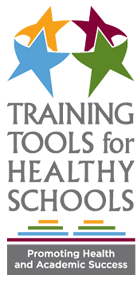Questions
How are schools doing in meeting the recommendations for a healthy school nutrition environment?
What are the nutrition standards for the National School Lunch and School Breakfast Programs?
What are the nutrition standards for Smart Snacks in School?
How can schools provide opportunities for students to learn about healthy eating?
Are schools required to provide students with access to drinking water during the school day?
A: According to national School Health Policies and Practices Study (SHPPS) 2014 data:
A: The standards are established by the U.S. Department of Agriculture and are aligned with the Dietary Guidelines for Americans. The last update, through the Healthy Hunger Free Kids Act of 2010, included revisions that reflect the 2010 Dietary Guidelines. These changes include:
- Ensuring students are offered fruits and vegetables every day of the week.
- Substantially increasing offerings of whole grain-rich foods.
- Offering only fat-free or low-fat milk varieties.
- Limiting calories based on the age of children being served to ensure proper portion size.
- Increasing the focus on reducing the amounts of saturated fat, trans fats, and sodium.
A: The standards, required by the Healthy, Hunger-Free Kids Act of 2010, require schools to offer healthier snack foods and beverages while limiting junk food. All foods and beverages sold at school during the school day must meet nutrition standards, including foods and beverages sold à la carte and in vending machines.
A: In addition to nutrition education classes, there are a number of ways schools can provide opportunities for students to learn about healthy eating. For example, schools can establish vegetable gardens or provide taste testing opportunities to introduce and sample new and nutritious foods.
A: Schools participating in the National School Lunch Program are required to make free drinking water available to students during lunch where the lunch meals are served. Schools participating in the School Breakfast Program must make drinking water available when breakfast is served in the cafeteria. In addition to these requirements, CDC recommends that schools make drinking water available throughout the school day by providing access to water fountains, dispensers, and hydration stations throughout the school; ensuring that water fountains are clean and properly maintained; and allowing students to have water bottles in class or to go to the water fountain if they need to drink water.
Links
CDC School Health Guidelines to Promote Healthy Eating and Physical Activity
[PDF - 973KB]
CDC Tips for Teachers
[PDF - 3.6MB]
CDC Water Access in Schools
CDC School Health Policies and Practices Study Results
CDC School Health Profiles 2014
Action for Healthy Kids. Parents for Healthy Kids
Rudd Roots Parents: Empowering Parent Advocates
School Meals: Nutrition Standards for School Meals
Team Nutrition Materials for Parents
The Smarter Lunchrooms Movement
Tools for Schools: Focusing on Smart Snacks
Key Resources
Parents for Healthy Schools: A Guide for Getting Parents Involved from K-12 [PDF - 9MB]
Parents for Healthy Schools: Making a Difference in Your Child’s School PowerPoint Presentation [PDF - 4MB]
Parent Engagement: Strategies for Involving Parents in School Health [PDF - 1.7MB]
Promoting Parent Engagement in School Health: A Facilitator’s Guide for Staff Development [PDF - 2.9MB]


